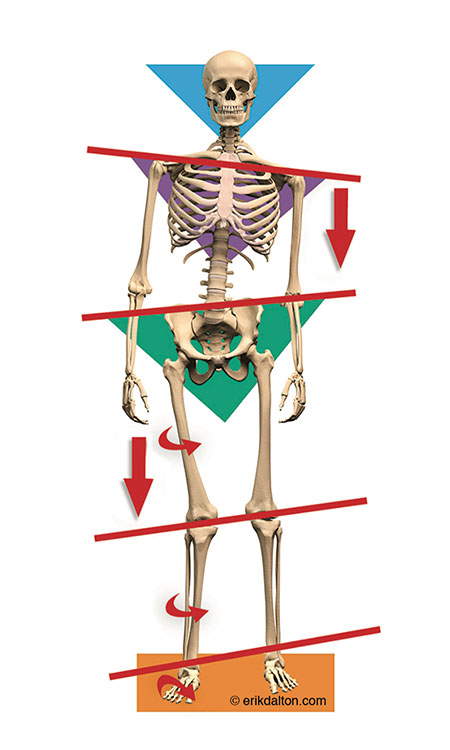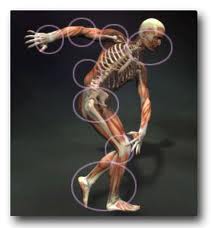How can my old ankle injury be the root cause of my hip pain now?
A: Do you know what a kinetic chain is?
The body is a series of kinetic chains starting from the foot to the ankle to the knee and works its way up the chain to the hips, low back and so forth. In a kinetic chain, movement of one joint affects movement of another joint within that kinetic chain. Do you remember the song we learned as kids “the knee bone is connected to the hip bone?” That song is right. Everything is connected in the body so if one part of the body is injured or affected then it affects often distant parts of the body, unbeknown to you!
When someone injures their ankle, for example a basketball player goes up for a layup; when they land, they invert or roll their right ankle and tear or stretch all the ligaments and tendons surrounding that joint… Or maybe someone was walking and they stepped off a curb wrong and roll their ankle… When that person goes to put weight on that ankle and take a step, they notice pain. Ouch! To avoid pain, they start to limp in an effort not to fully weight bear on the injured ankle. Due to compensation, the rest of the body now has to change to adapt to the injured ankle.
A good analogy is car alignment. If the car’s brakes are working and tires aligned, the 4 tires will wear evenly. If the car is out of alignment, some of the tires will wear unevenly and faster to make up for that bad alignment.
When you have pain, the body starts to compensate. In this case, due to the ankle injury, there is less body weight on the right ankle which causes the left side of the body to work harder.
This puts a lot of stress on the left side causing all those muscles to work harder and get tighter, while the right side is getting weaker. When the body starts to compensate to avoid pain, the body will begin to adapt to those changes. This isn’t good for the body over all because the body is now moving in an unbalanced motion pattern which leads to stress on the muscles, tendons, ligaments, joints and overall nervous system.
Your nervous system compensates too and thinks this is your new normal in the first 48 hours!
When you have an ankle injury and that ankle joint is not functioning properly, then the kinetic chain as a whole is not functioning properly. What started as unbalanced motion in the ankle can work its way up the chain to the knee, the hip joint and upward.
 In practice, these explanations are super relevant and important! New patients that have never experienced back pain before come in and say “I have this back pain that just started and I don’t know where it’s coming from, I haven’t done anything different.”
In practice, these explanations are super relevant and important! New patients that have never experienced back pain before come in and say “I have this back pain that just started and I don’t know where it’s coming from, I haven’t done anything different.”
Then in the history, I ask about recent events and they explain that they recently turned their ankle. I explain how the body is connected and how compensation due to pain and the resulting adaptation changes our biomechanics causing a domino effect throughout the body. It’s only in the examination with an eye to detail that we see the kinetic chain and explain that the ankle position is torqued and that they are not walking nor absorbing the shock of heel strike through their foot adequately. This will result in poor knee extension, hip rotation and pelvic torque, and somewhere, something will start to let you know it’s not happy about it. For them it just happens to be the lower back that is letting them know that there is a problem! Treating the whole kinetic chain, not just the point of pain will result in longer term results and a happy, and yes more educated patient. Adding appropriate exercises, fascial rolling and small ball work will assist in giving the patient tools to manage their problem at home.
It’s all in the details.
If you have pain in your body that you cannot pin an issue to, it is probably a kinetic chain issue. If you have had other health care professionals work on your issue, and it is still there, then we would like to help! Call The Foundation for Integrated Health at 604-988-7080; or go online to www.fih.janeapp.com to book with Dr. Aleem Remtulla or Dr. Linda Drake. You’ll be glad you did!

